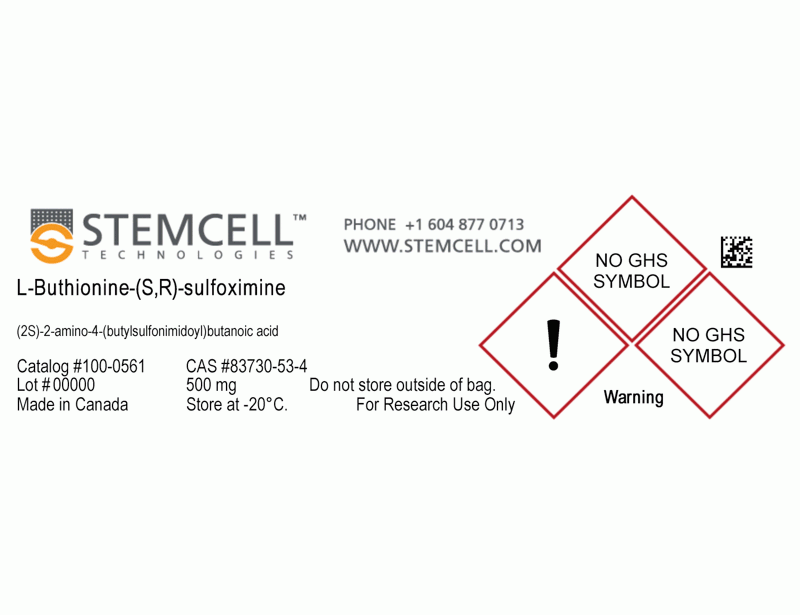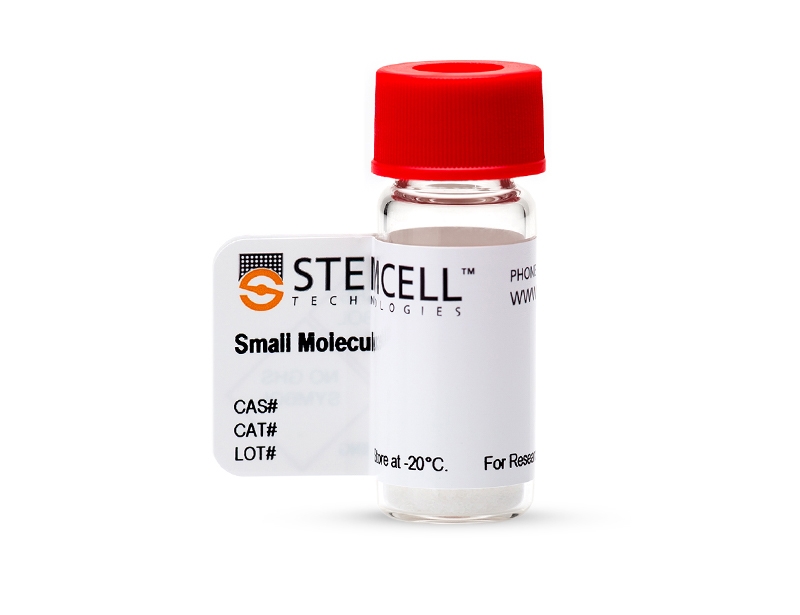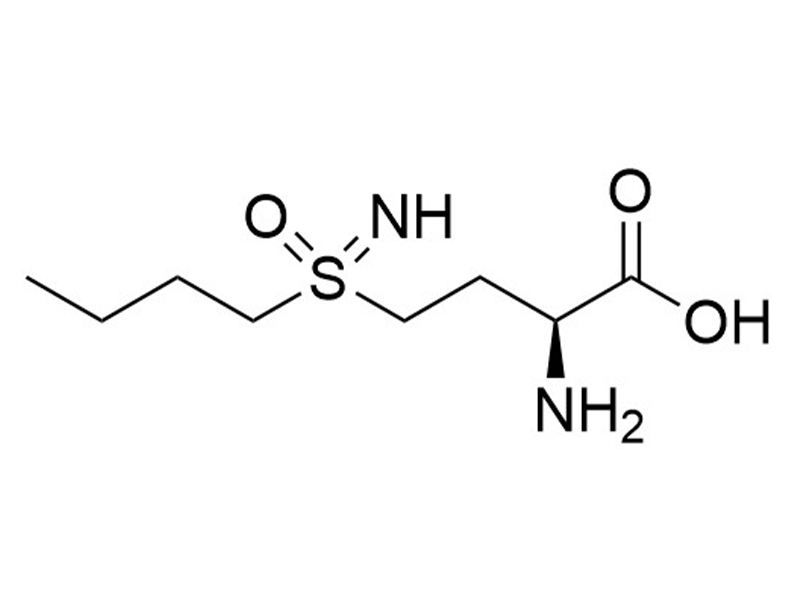概要
L-Buthionine-(S,R)-sulfoximine is a potent and irreversible inhibitor of γ-glutamylcysteine synthetase (γGCS; Ki < 100 μM) and used to deplete glutathione and sensitize cells to anticancer agents (Griffith; Hibi et al.; Lewis-Wambi et al.; Marengo et al.). γGCS is a rate-limiting enzyme in the glutathione (GSH) biosynthetic pathway and essential for glutathione homeostasis and cell survival (Hibi et al.).
CANCER RESEARCH
· Decreases glutathione levels and elevates reactive oxygen species production, leading to apoptosis in neuroblastomas (Marengo et al.).
· Predisposes estrogen-independent human breast cancer cells to estradiol-induced apoptosis (Lewis-Wambi et al.).
CANCER RESEARCH
· Decreases glutathione levels and elevates reactive oxygen species production, leading to apoptosis in neuroblastomas (Marengo et al.).
· Predisposes estrogen-independent human breast cancer cells to estradiol-induced apoptosis (Lewis-Wambi et al.).
技术资料
| Document Type | 产品名称 | Catalog # | Lot # | 语言 |
|---|---|---|---|---|
| Product Information Sheet | L-Buthionine-(S,R)-sulfoximine | 100-0560, 100-0561 | All | English |
| Safety Data Sheet | L-Buthionine-(S,R)-sulfoximine | 100-0560, 100-0561 | All | English |
数据及文献
Publications (4)
Free radical biology {\&} medicine 2008 feb
Mechanisms of BSO (L-buthionine-S,R-sulfoximine)-induced cytotoxic effects in neuroblastoma.
Abstract
Abstract
Glutathione (GSH) depletion is widely used to sensitize cells to anticancer treatment inducing the progression of programmed cell death and overcoming chemoresistance. It has been reported that neuroblastoma cells with MYCN amplification are unable to start TRAIL-dependent death and MYCN, in concert with cytotoxic drugs, efficiently induces the mitochondrial pathway of apoptosis through oxidative mechanisms. In this study, we show that GSH loss induced by L-buthionine-S,R-sulfoximine (BSO), an inhibitor of GSH biosynthesis, leads to overproduction of reactive oxygen species (ROS) and triggers apoptosis of MYCN-amplified neuroblastoma cells. BSO susceptibility of SK-N-BE-2C, a representative example of MYCN-amplified cells, has been attributed to stimulation of total SOD activity in the absence of changes in the level and the activity of catalase. Therefore, the unbalanced intracellular redox milieu has been demonstrated to be critical for the progression of neuroblastoma cell death that was efficiently prevented by antioxidants and rottlerin. These results describe a novel pathway of apoptosis dependent on ROS formation and PKC-delta activation and independent of p53, bcl-2, and bax levels; the selective redox modulation of PKC-delta might be suggested as a potential strategy for sensitizing MYCN-amplified cells to therapeutic approaches.
Breast cancer research : BCR 2008
Buthionine sulfoximine sensitizes antihormone-resistant human breast cancer cells to estrogen-induced apoptosis.
Abstract
Abstract
INTRODUCTION Estrogen deprivation using aromatase inhibitors is one of the standard treatments for postmenopausal women with estrogen receptor (ER)-positive breast cancer. However, one of the consequences of prolonged estrogen suppression is acquired drug resistance. Our group is interested in studying antihormone resistance and has previously reported the development of an estrogen deprived human breast cancer cell line, MCF-7:5C, which undergoes apoptosis in the presence of estradiol. In contrast, another estrogen deprived cell line, MCF-7:2A, appears to have elevated levels of glutathione (GSH) and is resistant to estradiol-induced apoptosis. In the present study, we evaluated whether buthionine sulfoximine (BSO), a potent inhibitor of glutathione (GSH) synthesis, is capable of sensitizing antihormone resistant MCF-7:2A cells to estradiol-induced apoptosis. METHODS Estrogen deprived MCF-7:2A cells were treated with 1 nM 17beta-estradiol (E2), 100 microM BSO, or 1 nM E2 + 100 microM BSO combination in vitro, and the effects of these agents on cell growth and apoptosis were evaluated by DNA quantitation assay and annexin V and terminal deoxynucleotidyl transferase dUTP nick end-labeling (TUNEL) staining. The in vitro results of the MCF-7:2A cell line were further confirmed in vivo in a mouse xenograft model. RESULTS Exposure of MCF-7:2A cells to 1 nM E2 plus 100 microM BSO combination for 48 to 96 h produced a sevenfold increase in apoptosis whereas the individual treatments had no significant effect on growth. Induction of apoptosis by the combination treatment of E2 plus BSO was evidenced by changes in Bcl-2 and Bax expression. The combination treatment also markedly increased phosphorylated c-Jun N-terminal kinase (JNK) levels in MCF-7:2A cells and blockade of the JNK pathway attenuated the apoptotic effect of E2 plus BSO. Our in vitro findings corroborated in vivo data from a mouse xenograft model in which daily administration of BSO either as a single agent or in combination with E2 significantly reduced tumor growth of MCF-7:2A cells. CONCLUSIONS Our data indicates that GSH participates in retarding apoptosis in antihormone-resistant human breast cancer cells and that depletion of this molecule by BSO may be critical in predisposing resistant cells to E2-induced apoptotic cell death. We suggest that these data may form the basis of improving therapeutic strategies for the treatment of antihormone resistant ER-positive breast cancer.
Proceedings of the National Academy of Sciences of the United States of America 2004 oct
Crystal structure of gamma-glutamylcysteine synthetase: insights into the mechanism of catalysis by a key enzyme for glutathione homeostasis.
Abstract
Abstract
Gamma-glutamylcysteine synthetase (gammaGCS), a rate-limiting enzyme in glutathione biosynthesis, plays a central role in glutathione homeostasis and is a target for development of potential therapeutic agents against parasites and cancer. We have determined the crystal structures of Escherichia coli gammaGCS unliganded and complexed with a sulfoximine-based transition-state analog inhibitor at resolutions of 2.5 and 2.1 A, respectively. In the crystal structure of the complex, the bound inhibitor is phosphorylated at the sulfoximido nitrogen and is coordinated to three Mg2+ ions. The cysteine-binding site was identified; it is formed inductively at the transition state. In the unliganded structure, an open space exists around the representative cysteine-binding site and is probably responsible for the competitive binding of glutathione. Upon inhibitor binding, the side chains of Tyr-241 and Tyr-300 turn, forming a hydrogen-bonding triad with the carboxyl group of the inhibitor's cysteine moiety, allowing this moiety to fit tightly into the cysteine-binding site with concomitant accommodation of its side chain into a shallow pocket. This movement is caused by a conformational change of a switch loop (residues 240-249). Based on this crystal structure, the cysteine-binding sites of mammalian and parasitic gammaGCSs were predicted by multiple sequence alignment, although no significant sequence identity exists between the E. coli gammaGCS and its eukaryotic homologues. The identification of this cysteine-binding site provides important information for the rational design of novel gammaGCS inhibitors.
The Journal of biological chemistry 1982 nov
Mechanism of action, metabolism, and toxicity of buthionine sulfoximine and its higher homologs, potent inhibitors of glutathione synthesis.
Abstract

 网站首页
网站首页





